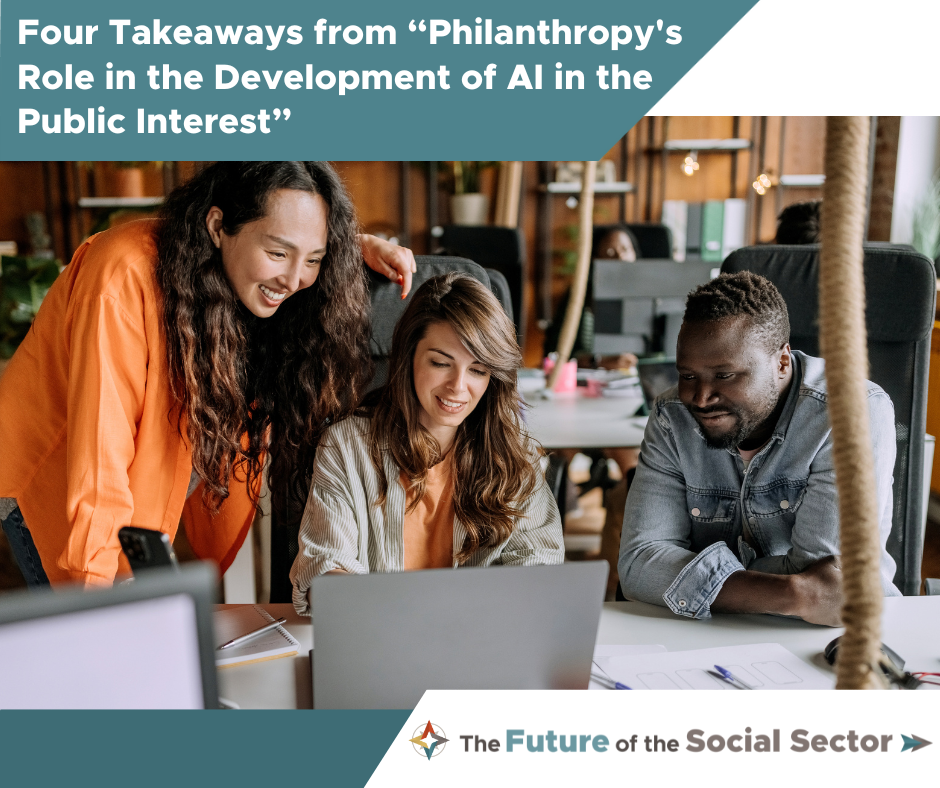Four Takeaways from “Philanthropy’s Role in the Development of AI in the Public Interest”

The past year has brought an explosion of interest in large language models, such as ChatGPT, and other artificial intelligence (AI) tools. The general public is increasingly using AI in daily life, from running complex search queries to enjoying self-driving cars to creating written content—and all signs point to this trend accelerating. In fact, Grand View Research reported that the AI market size is expected to increase at a rate of 37.3 percent annually over the next seven years.
As with most technological advancements, AI presents both tremendous opportunities and significant risks. For example, the advent of the internet changed society for the better in innumerable ways, but it also brought unanticipated harms, including misinformation that undermines democracy. If we’re not careful, the same can happen with AI.
Fortunately, philanthropy can play a role in preventing similar harms as AI becomes more and more ubiquitous. As funders consider whether they’d like to invest in this growing field—either directly or because AI intersects with their primary focus area, such as democracy or climate change—we urge them to explore it using a public interest technology (PIT) lens.
Public interest technology is a fast-growing field that seeks to ensure technology is created and used responsibly—and used to serve the public good. PIT brings computational and social science disciplines together with developers, advocates, and community leaders to determine how to most effectively use technologies such as AI in ways that protect the public and ensure all people—not just some—can benefit from them.
Arabella recently invited several PIT experts to join us for a webinar (watch the recording here) to discuss the role philanthropy can play in developing AI tools that support the public interest. The panel included Moez Draief, managing director at Mozilla.ai; Katy Knight, executive director and president of Siegel Family Endowment; Mark Surman, president of the Mozilla Foundation; and Jenny Toomey, director of the Catalyst Fund from the Ford Foundation. Shelley Whelpton, a senior managing director at Arabella, moderated the panel.
In an optimistic and forward-looking conversation, panelists discussed the history and future of AI, philanthropy’s current involvement in the AI sector, and the role philanthropy can and should play going forward. We’re pleased to share the following four takeaways from the conversation:
- Takeaway 1: AI will be a component of your work—if it’s not already. Funders should think critically now about how they can leverage technologies such as AI to advance their and their grantee partners’ work, because no field or issue area is unaffected. Technology is already contributing to both the challenges and the solutions of most if not all of the issues we are grappling with, from democracy to climate to education. We’re already seeing how AI has and will continue to create drastic change in how we work and live. Many of us often think of tech as a siloed issue area, but panelists urged participants to shift away from that mindset and embrace technology’s role in achieving their goals.
- Takeaway 2: Philanthropy can support tech in building a more diverse workforce to both combat bias and better meet the needs of more communities. Thus far, AI has not been made available globally, leaving out huge swaths of people, languages, and cultures from informing the emerging large language models. If not addressed, this will likely embed bias and discrimination into the models. To help prevent bias in new and existing technological tools, ensure representative datasets, and lead us to create equitable tools that communities truly need, we need to continue to build the pipeline of technologists from diverse backgrounds. These individuals can help ensure the data that inform the models are more representative of more people. And, because they are better positioned to understand the unique challenges of underrepresented communities, they can guide the tech sector more broadly to prioritize creating tools that meet the needs of often-overlooked populations. The Public Interest Technology University Network, which includes 59 universities, is already doing this work effectively: PIT-UN supports university programs that aim to build a more diverse pipeline of technologists who are committed to advocating for the public interest.
- Takeaway 3: Philanthropy has the unique ability to support public alternatives to tech tools that are now being created and deployed predominately by the private sector. Currently, corporations are driving tech innovation and development, and we’re seeing that speed, scale, and market share frequently come at the expense of the public interest. When broadcasting was emerging, philanthropy decided to take steps to make it publicly available—for example, by funding PBS—and the sector can do the same with AI technology. Creating publicly available AI tools would increase access to these systems in communities that otherwise might be unable to benefit from them. As Mark Surman explained, this would shift “the norms more toward empowerment and less toward harm” by reducing corporate control over the technology.
- Takeaway 4: You don’t have to do this alone. There are experts who have been working in this field for years who can guide you to ensure your investments are reaching organizations that are promoting responsible tech and actively mitigating the potential harms that technology can lead to if not built or implemented with a public interest lens.
We are at a crucial inflection point where philanthropy must act. Philanthropic investments can be a critical force for preventing harm from AI and ensuring that future tech tools are built with human needs, goals, and lived experiences in mind. If you’re curious about ways to integrate this work into your existing portfolio or would like to explore joining a community of likeminded donors, please reach out to Erin Spence, who can connect you with experts in our network. We’d love to continue the conversation with you; don’t hesitate to reach out.
